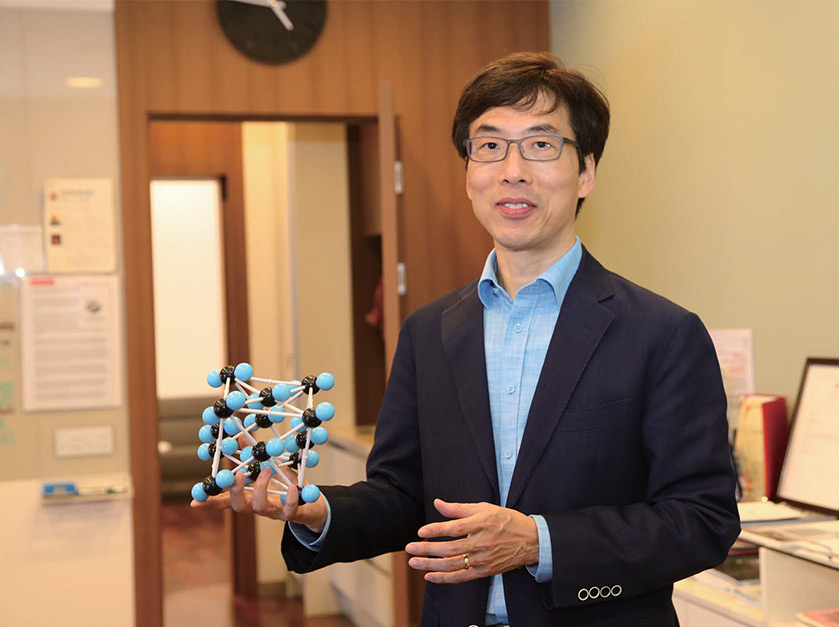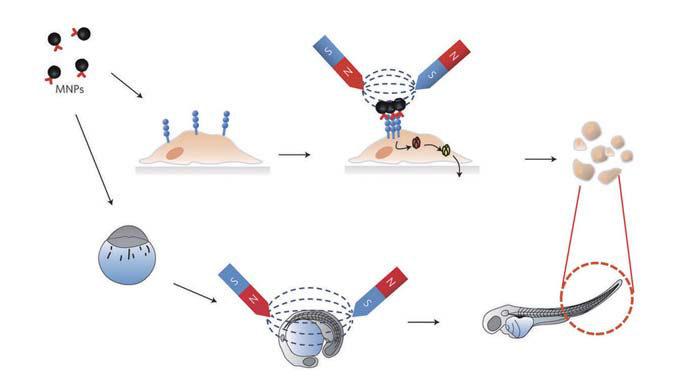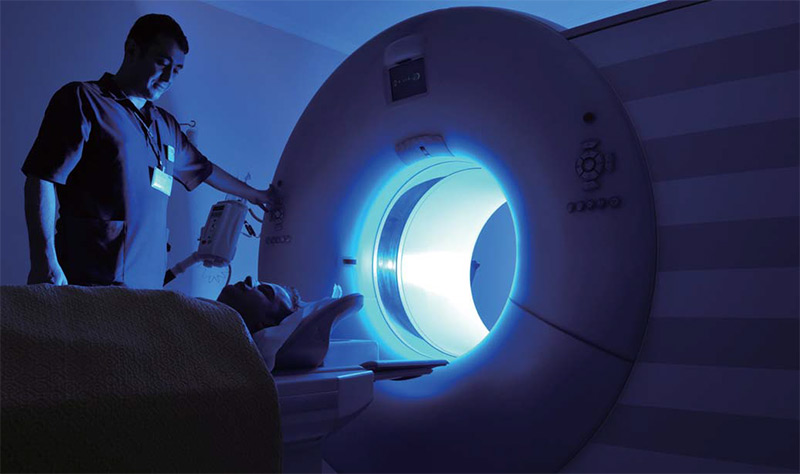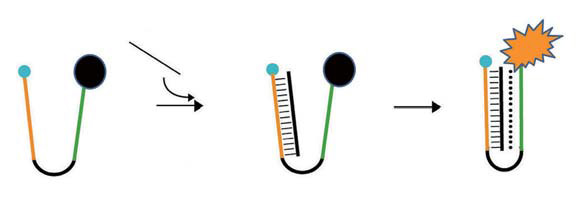In early 2016, construction of a four-story research building with a budget of more than 10 billion won (approx. 9 million US dollars) will begin at the Sinchon campus of Yonsei University in Seoul. The architectural design for the building is currently underway. This new building which will house the Center for Nanomedicine a new IBS Center, will facilitate collaborations among some of the world’s leading scientists and also nurture young researchers to lead the future global scientific community. It is rare for a university to build a research facility for a single professor. This means that Yonsei University’s expectations are high for Director Jinwoo Cheon, who is the first Yonsei professor to become an IBS Director.

Director Jinwoo Cheon Center for Nanomedicine.
“Above all, the IBS building is oriented towards interdisciplinary research. In order to realize true convergence and gather people from various fields, we need to have the right building design and research facilities,"
“There is a lot of work to be done because we are going to make the building not just for research but also a scientific communication plaza for innovative ideas as well. We will also provide the best scientific environment to Yonsei researchers and visitors so that they can have a special experience and share it with others. Above all, the IBS building is oriented towards interdisciplinary research. In order to realize true convergence and gather people from various fields, we need to have the right building design and research facilities,” said Director Cheon.
In an interview with the IBS Research at a restaurant located in Gwanghwamun, Seoul on November 10, Director Cheon said, “I have just been to a meeting with an architect to discuss the design of the IBS building.” He added that, although it is a little behind the initial schedule, the building will begin construction in early 2016 without further delays.
Research on nanoparticles for cancer treatment and “nanoswitches” that control biological processes

Schematic illustration of magnetic nanoswitch experiments demonstrated in zebrafish, a member of the minnow family. Apoptosis, which is a process of programmed cell death, can be rtificially induced by applying an external magnetic field to death receptorbound magnetic nanoparticles.
©Jinwoo Cheon et al /Nature
Materials 2012
Director Cheon is one of the world’s most renowned researchers in nanoscience, which focuses on materials at the nanometer (1 nm = 1 billionth of a meter) level. Nanoscience has already been applied in almost all scientific fields, including chemistry, physics, biology, and materials engineering. For the past decade, Director Cheon has also pioneered “nanomedicine” with his innovative approaches. Director Cheon said, “Nanomaterials can communicate with each cell in the human body. If we could develop nanomaterials that target somatic cells such as nerve cells, skin cells, and vascular cells, we could better understand numerous diseases and disorders and then potentially treat them in more effective ways"
For the last 10 years, Director Cheon has ledsub-fields of nanomedicine using nanoscience. This is best exemplified by the development of new ways to treat cancer. After magnetic nanoparticles such as iron oxide with thermal effects 30 times stronger than conventional ones are injected into cancer cells, they are exposed to an alternating magnetic field, and the particles begin to give off heat that actually burns the cancer cells to death.
According to Director Cheon, “Compared with existing anticancer drugs, nanoparticles are more effective because they can focus their attack only on cancer cells at the right time.” Typically, anticancer drugs are introduced into the whole body, and both cancer cells and healthy cells are subjected to their effects. Radiation therapy also has serious side effects such as hair loss and nausea. Such challenges in modern cancer treatments sometimes lead to false beliefs among desperate patients. Opinions such as, “You would live longer if you do not get cancer treatment,” and “Cancer treatment is a road to death” have recently been expressed in some alternative medicine fields. Although it is still a long way to make them really useful in the clinic, some of Director Cheon’s methods constitute a breakthrough technology that could contribute to solving important problems related to disease diagnosis and treatment.
Recently, Director Cheon has focused on “nanoswitches” that stimulate biological signaling processes. Just like turning on and off an electric switch, nanoswitches in the body can be triggered to open up a clogged blood vessel or modulate hormone release.
“Currently, diseases that afflict the brain and nervous systems such as auditory hearing loss and Alzheimer’s can be marginally treated with drugs. These two diseases, which are increasing significantly every year, are some of the most serious problems in our society. However, it is not easy to obtain the desired results with conventional drugs.” said Director Cheon.
Highly effective cure of hearing loss and Alzheimer’s drugs have not been developed yet. Director Cheon emphasized that interfacing nanoparticles into targeted disease area and activating them by using external stimuli could control cell signaling that governs the body’s natural behaviors.
“Nanoswitches could stimulate your nerve cells to release hormones that promote feelings of wellbeing. They could also stimulate the cells of clogged or broken blood vessels so that they can regenerate quickly, while they have already proven effective for cancer treatments in animals as well. If the exact causes of these disease are identified, it would be possible to use nanoswitch technology to the human body for better treatments,” explained Director Cheon.
Recognition from Korea and Abroad

Magnetic nanoswitches developed by Director Cheon provide a new way to selectively remove cancer cells. This study is expected to significantly contribute to the development of effective cancer treatment methods with reduced side effects.
In recognition of his achievements in the field of nanomedicine, Director Cheon has received a series of major Korean science awards, including the Inchon Prize in 2011, the ChungAm Prize in 2012, and the Hoam Prize in 2015.
In late April 2014, Director Cheon was designated the Director of the Center for Nanomedicine within IBS. IBS President Doochul Kim said, “Director Cheon is a worldclass researcher, I believe nanomedicine will become one of the flagship scientific fields in Korea.”
Director Cheon has become one of the world's leaders in the fields of nanoscience and nanomedicine, but not without his fair share of twists and turns. He received his bachelor’s and master’s degrees from Yonsei University and his Ph.D. from the University of Illinois at Urbana-Champaign. As he reached the end of post-doctoral training in inorganic materials chemistry, he began to think about his future seriously.
“My colleagues were offered jobs one after another, but I fell short of my expectations. Since I really wanted to work at academia, Iwent to see my supervising professor to ask if I could get a job at one of the niversities in the U.S. He said that, given my research achievements, it would possible for me to get a job, but not likely at a top-class U.S. university
I thought about returning to Korea as well, but at that time Korea was going through the major "IMF" financial crisis. I kept trying and luckily started a new position at the Korea Advanced Institute of Science and Technology (KAIST),” said Director Cheon.
In his first year at KAIST, Director Cheon received a government grant of only 13 million won (approx. 11,000 US dollars), which was far from enough for a young professor to realize his ambitions. It was not even enough to buy suitable analytical instruments. So Director Cheon began to focus on the synthesis of nanomaterials, which requires only flasks and ideas. Back in those days, “nanoscience” was not a very familiar concept in Korea. And although some of his colleagues were skeptical, Director Cheon persevered.
After more than two years, Director Cheon developed—for the first time—a method to fabricate nanoparticles in desired shapes such as pentagrams, asymmetric bars, and cubes. This research was ultimately published in renowned international journals.
Starting as a newly appointed professor who almost nobody recognized, Director Cheon has now become a leading scientist who is recognized as a frontrunner by the global nanoscience and nanomedicine community. Like Lord Byron, he one day woke up and found himself to be a leader in the field, but of course, it was thanks to his relentless efforts. Just as Japanese scientists were early pioneers in particle physics, Director Cheon has led the way in doing the same for nanomaterials science and nanomedicine. And he did it all starting with just flasks and ideas instead of sophisticated and costly research equipments.

A method to assess how nanoswitches target DNA. A hairpin shaped nanoswitch (left panel) has a quenched fluorophore whose fluorescence is restored when it binds to a target DNA (right panel). This allows to confirm the DNA targeting of the nanoswitch.© Francesco Ricci / University of Rome, Tor Vergata.
“In publishing my research papers, I came to realize that the word ‘first’ is most important. Anyone can conduct research. But there is no way to keep your job as a professor if you do not make new research progress. Therefore, if you started your career as a scientist, you must have an ambition to achieve something new and better than what anyone else has done,” explains Director Cheon.
He has now published more than 120 papers in world-renowned journals, and Director Cheon was designated as one of Thomson Reuter’s Highly Cited Researchers in both 2014 and 2015. This shows that the originality and the impact of his work has been recognized worldwide. In recognition of his research achievements in nanochemistry and nanomedicine, Director Cheon was appointed Fellow of the American Chemical Society (ACS) and Royal Society of Chemistry (RSC). Since 2009, he has also been working as a senior editor of the Account of Chemical Research, a major international chemistry journal. The journal has two editional offices, one of which is located at Yonsei University. These kinds of achievements cannot be earned through a researcher's competence alone; it also requires perseverance.
There is other evidence to demonstrate Director Cheon's knack for finding breakthroughs in new fields of reasearch: "In 2000, my research team found that the shapes of quantum dots, which are nanometer-size light-emitting semiconductor crystals, could be easily controlled. However, there was an eminent American team whose research was at least six months ahead of ours. Although I was sure that quantum dots would become a breakthrough material in the field of display technology, I simply gave up on my research on quantum dots and decided to develop new materials with different properties instead of trying to catch up research teams ahead of us. In the world of science where talented researchers are striving to create stateof-the-art technology, it is not easy to eliminate a gap of even six months. That’s why I came to focus on new topics of magnetic nanomaterials and also nanomedicine, which, in fact, had high growth prospects despite the lack of attention they received at that time.”
“To be remembered as a pioneer in a new field of science”
Director Cheon moved from KAIST to Yonsei University for a very specific reason. Although he had done important work at KAIST and became a rising scientist thanks to their support, Yonsei is his alma mater and also has an important advantage that he could not resist: a world class medical school. Of course, Director Cheon is not a medical doctor. In the new field of nanomedicine, however, collaboration with medical scientists is of great importance because new technologies must be extensively tested for their suitability in the human body before they can be released. In this context, Director Cheon defines nanomedicine as, “interdisciplinary convergence research that forms a bridge between nanoscience and life.”
“I am a scientist. I try to develop novel nanomaterials and identify the new scientific principles underlying them. However, in order for my science to be truly useful, they must be capable of serving humans. That’s why I need collaboration with researchers from medical schools. The ultimate aim of nanomedicine can be achieved only when experts of human anatomy are able to apply my materials and technologies to humans. I am planning to recruit medical school professors to the new Yonsei-IBS Center for Nanomedicine. I am sure that putting our heads together will speed up the development of nanomedicine,” said Director Cheon.
What is Director Cheon’s ultimate goal? His answer to this question was simple and straightforward: “to be remembered as a pioneer in a new field of research.” In other words, he wants to develop a new discipline and have people remember his name for that achievement, just as James Watson and Francis Crick are remembered as the discoverers of DNA.
For Director Cheon, “A diligent attitude, rather than a casual discovery, tends to result in excellent research outcomes, which is something I think all scientists can agree with. I will diligently try to pursue innovative science for the interfacing between materials and biological systems, which will eventually leads into better diagnosis and treatment of diseases. As long as one keeps searching for new knowledge, one will be able to find nature's answers."


 thumb.jpg
thumb.jpg















